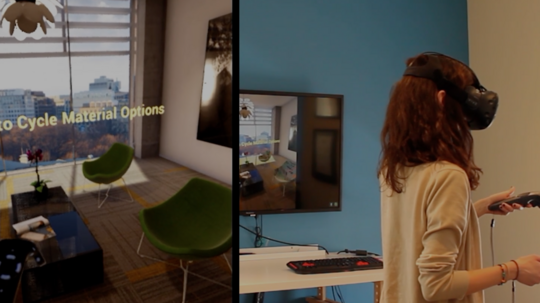
Though still in its infancy, virtual and augmented reality are opening up new approaches to industries that for decades have been technologically stagnant. Locally based Illustrate My Design is taking a stab at the nascent tech by applying it to architecture.
Ten-year-old IMD aims to bridge the gap between professionals and non-professionals in the real estate design process by creating visual experiences for projects before shovels hit dirt.
“There’s typically a misunderstanding when engineers are putting technical drawings in front of people, and there are just nods,” co-founder Florenica Bialet said. “Ninety percent of the general public can’t imagine 3-D space – when you talk about the size of a room or ceiling height, those translations into a mental image just don’t happen for most people.”
To solve the miscommunication, IMD creates photo-like 3-D renderings of building projects, using technical drawings, architectural specs and animation to bring the project to life on a computer screen. For example, a client can virtually walk through a predetermined path in a yet-unbuilt space, turning 360 degrees at any time and seeing virtual people walking around and using the space.
Bialet said IMD’s services contribute to three parts of a project’s lifecycle. Builders can try to fundraise or win a contract with the help of interactive renderings; designers and end users can collaborate during development with a shared understanding of the space’s features; and marketing and sales content is easy to pluck from the files.
The project’s 3-D file provides content for all three of those situations. But it doesn’t stop at a laptop screen.
“Animation and VR is really where everything is going in the industry,” Bialet said. “3-D renderings is where you start, but you have to develop the model to include things you want to show, and animation and VR builds on that.”
For example, IMD can host clients at a building site and give them VR glasses to see what the finished space will look like, creating an instant before/after picture in three dimensions.
"With today’s noise, you have to have a lot of content to draw people to projects."
It’s also been experimenting with using greenscreen technology to insert footage of actual people into the renderings. Bialet said that ranges from basics, like someone having coffee in a kitchen space, to a physician and patient interacting in an office, to a hallway full of same-age students in uniform.
Creating those and other new types of content is critical to IMD staying ahead of the curve.
"Construction typically can last months or a year, and that’s a long time to keep somebody’s interest," she said. "With today’s noise, you have to have a lot of content to draw people to projects."
As another example, IMD worked with the U.S. Capitol building three times during its renovation a few years ago. It created a 3-D model of the building, and using the construction timeline, simulated how the crews would move over the course of the renovation, allowing the Capitol architect to consider crew sizes, timing and security.
The company’s 10 employees are spread throughout its main studio in Old Town Alexandria and two other offices in D.C. and Miami. Bialet said a majority of its work so far has been in the D.C. area, but with so much design work becoming digital, IMD is looking to expand out of the region.




